Best Places to Dive: Kona, Hawaii
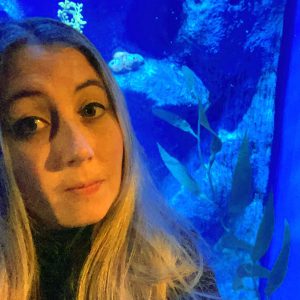 Kona, Hawaii is world-renowned for two things: Kona coffee and swimming with manta rays at night.
Kona, Hawaii is world-renowned for two things: Kona coffee and swimming with manta rays at night.
While the mineral-rich volcanic soil and mild climate of Kona has created one of the most expensive coffees in the world, a bit of Pavlovian conditioning has led to a reliably fantastic dive site. With wingspans of up to 23 feet, manta rays are gentle giants that have become drawn to the underwater light systems that both light up their viewing site and attract the plankton they feed on. This little spot on the western side of the Big Island may be known for its night dives with manta rays, but aquarist Mallory Haskell also reported terrific daytime diving as well.
“The water was crystal clear and we saw soooooo many of the colorful tropical fish you think of with reefs,” Mallory says. She also swam with spotted eagle rays and white tip reef sharks in Kona’s waters. Mallory worked at Greater Cleveland Aquarium from 2012 to 2014 and was certified to dive during this stint. She returned to the Aquarium in 2018.
As if Hawaii didn’t have enough going for it, the steep slopes of the volcanic mountains plummet prodigiously just off the coast of Kona. Three miles offshore, the water is 1000 fathoms deep. For those who haven’t read Moby Dick recently, a fathom is equivalent to six feet, meaning there’s a mile drop off and a bevy of large pelagic fish near shore – marlin, wahoo, sailfish and mahi mahi included.
Kona, Hawaii is the seventh in our weekly series of the Aquarium dive team’s favorite dive locations. Stay tuned for the remaining three destinations and suggest somewhere new we might want to explore.
- Ray D.

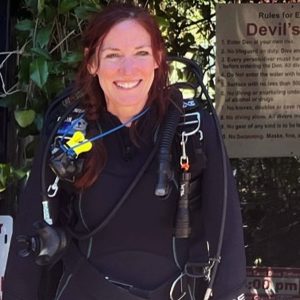 Not every diver seeks tropical water and colorful fish. For some, the lure of historic shipwrecks or the challenge of cold-water diving draw them further north and inland to freshwater lakes. The Great Lakes is a wonderful location to find thousands of wrecks that, due to the lack of corrosive saltwater and stronger ocean currents, tend to be better preserved.
Not every diver seeks tropical water and colorful fish. For some, the lure of historic shipwrecks or the challenge of cold-water diving draw them further north and inland to freshwater lakes. The Great Lakes is a wonderful location to find thousands of wrecks that, due to the lack of corrosive saltwater and stronger ocean currents, tend to be better preserved. In 1999, a daring spearfisherman in Greece named Manolis Efthymakis made a stunning discovery. While free-diving 30 feet down, he saw an opening in the cliff wall and did what most of us would not: he swam into it. What he found drew the interest of both the diving and the archaeological community.
In 1999, a daring spearfisherman in Greece named Manolis Efthymakis made a stunning discovery. While free-diving 30 feet down, he saw an opening in the cliff wall and did what most of us would not: he swam into it. What he found drew the interest of both the diving and the archaeological community.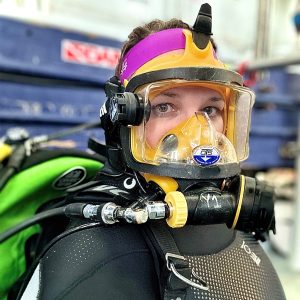 Just eight degrees south of the equator and nearly 10,000 miles from Cleveland, the island of Bali is a province of Indonesia and lies within the Coral Triangle, an area of immense biodiversity between the Pacific and Indian Oceans.
Just eight degrees south of the equator and nearly 10,000 miles from Cleveland, the island of Bali is a province of Indonesia and lies within the Coral Triangle, an area of immense biodiversity between the Pacific and Indian Oceans. A shade over 66 million years ago, a six-mile-wide meteor came screaming out of the heavens at 12 miles per second and a 60-degree angle to the surface of the Earth, which is kind of a worst-case scenario angle in terms of plunging chunks of space rock. It absolutely pulverized the impact zone with the force of a 100 million megaton bomb, creating tsunamis hundreds of feet high and flinging rocks half a continent away. For non-avian dinosaurs, the impact marked the end of an era. Literally. This is where the Mesozoic Era ended, and the Cenozoic began—the infamous K-T Extinction that eliminated roughly 80 percent of all species on the planet.
A shade over 66 million years ago, a six-mile-wide meteor came screaming out of the heavens at 12 miles per second and a 60-degree angle to the surface of the Earth, which is kind of a worst-case scenario angle in terms of plunging chunks of space rock. It absolutely pulverized the impact zone with the force of a 100 million megaton bomb, creating tsunamis hundreds of feet high and flinging rocks half a continent away. For non-avian dinosaurs, the impact marked the end of an era. Literally. This is where the Mesozoic Era ended, and the Cenozoic began—the infamous K-T Extinction that eliminated roughly 80 percent of all species on the planet. When
When 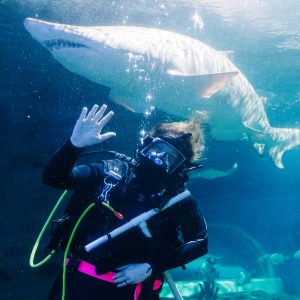 We dive for a variety of reasons. To commune with nature, to unwind, to explore. Our “pale blue dot,” as astrophysicist and author Carl Sagan pointed out, is just a “very small stage in a vast cosmic arena,” but perhaps by diving in we can learn to better appreciate that fragile ecosystem largely invisible to us as we commute between school, work and the grocery store in our busy daily lives.
We dive for a variety of reasons. To commune with nature, to unwind, to explore. Our “pale blue dot,” as astrophysicist and author Carl Sagan pointed out, is just a “very small stage in a vast cosmic arena,” but perhaps by diving in we can learn to better appreciate that fragile ecosystem largely invisible to us as we commute between school, work and the grocery store in our busy daily lives. Scuba diving and Cleveland, Ohio . . . sort of go together like peanut butter and monkey wrenches, right? I challenge you to find one of those “101 Places to Dive Before You Die” books with a cover that isn’t turquoise, tropical and filled with colorful reef fish. And yet Cleveland has its own extensive dive community. Lake Erie, the shallowest of the Great Lakes, has hundreds of shipwrecks to explore and is serviced by several dive shops that teach classes, sell gear, and organize trips all over the world. Northeast Ohio is home to around 4.5 million people and an untold amount of scuba divers who love to explore the waters in their own backyard as well as adventure to distant places to see what there is to see in the 70% of our planet that is underwater.
Scuba diving and Cleveland, Ohio . . . sort of go together like peanut butter and monkey wrenches, right? I challenge you to find one of those “101 Places to Dive Before You Die” books with a cover that isn’t turquoise, tropical and filled with colorful reef fish. And yet Cleveland has its own extensive dive community. Lake Erie, the shallowest of the Great Lakes, has hundreds of shipwrecks to explore and is serviced by several dive shops that teach classes, sell gear, and organize trips all over the world. Northeast Ohio is home to around 4.5 million people and an untold amount of scuba divers who love to explore the waters in their own backyard as well as adventure to distant places to see what there is to see in the 70% of our planet that is underwater.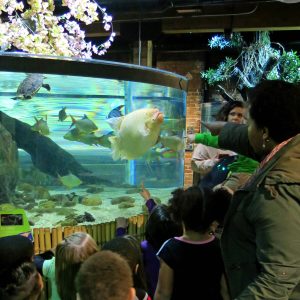 I was hired at Greater Cleveland Aquarium in November 2011 and with the exception of a COVID-related furlough, I have worked here as an employee ever since. I started off as a Guest Experience Associate—one of the welcoming team members stationed in our galleries to answer any and all inquiries about the animals or the facility. I then transferred to the Education Department as an Associate leading school tours. I was briefly an Education Assistant, which required that I book and schedule all tours, help develop and implement all materials for each grade and group that visits and collecting and processing payments. Eventually I took on the role of Office Assistant, and I have been doing the job ever since.
I was hired at Greater Cleveland Aquarium in November 2011 and with the exception of a COVID-related furlough, I have worked here as an employee ever since. I started off as a Guest Experience Associate—one of the welcoming team members stationed in our galleries to answer any and all inquiries about the animals or the facility. I then transferred to the Education Department as an Associate leading school tours. I was briefly an Education Assistant, which required that I book and schedule all tours, help develop and implement all materials for each grade and group that visits and collecting and processing payments. Eventually I took on the role of Office Assistant, and I have been doing the job ever since. There are so many more, but those are the ones that stand out in my memory. I must say that I look forward to countless more in my next 10 years!
There are so many more, but those are the ones that stand out in my memory. I must say that I look forward to countless more in my next 10 years!